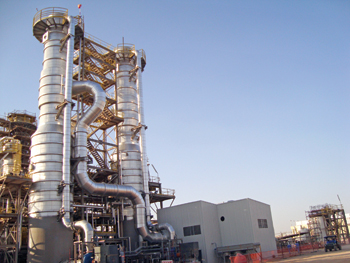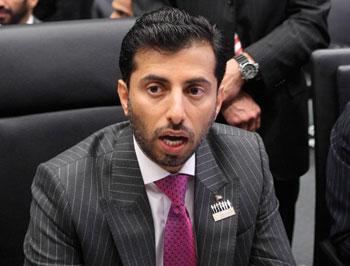
DOLPHIN Energy Limited’s (DEL) gas import pipeline into the UAE from Qatar is significantly underused, meaning parts of the UAE will continue to burn diesel and fuel oil to generate power.
Dolphin, a producer and regional distributor of natural gas from Qatar, says it has been importing up to 300,000 mmcfd of gas diverted from Qatar’s LNG plants during the summer. Total gas movements through the pipeline have been as high as 2.3 bcfd in recent months, well below the line’s 3.2 bcfd capacity.
Dolphin’s gas exports from Qatar started at 2 bcfd in late 2007. The company had originally hoped to secure permits to develop further gas production capacity in Qatar, but that aspiration fell by the wayside in 2005 when Qatar placed a moratorium on North Field development beyond that required to supply planned LNG developments and for domestic consumption.
The additional seasonal gas deliveries to customers in the UAE and Oman ran from June to September, a period of high regional demand for gas due to increased power generation required for air-conditioning which coincides with lower gas demand in Asian and European countries which import LNG from Qatar.
The disclosure marks the first time that Dolphin, a consortium of UAE state-owned Mubadala Development (51 per cent), France’s Total (24.5 per cent) and the US’ Occidental Petroleum (24.5 per cent), has quantified the third-party summer gas volumes it has purchased to send through its undersea pipeline from Qatar to Taweelah on the coast of the UAE’s Abu Dhabi emirate, and then through an overland pipeline systems to state-owned industrial and power-sector customers.
In a study published in July, Dubai-based Manaar Energy Consulting and Project Management estimated that the UAE’s five northern emirates were burning oil to generate about 25 per cent of their power supply. In the past five years, Sharjah alone has consumed as much as 40,000 bpd of light and heavy fuel oil to generate power during peak summer demand months.
Abu Dhabi, the leading UAE emirate with more than 90 per cent of the UAE’s oil and gas reserves, does not burn oil to generate power but its ability to export power to the less developed northern emirates has been declining. The UAE is developing 5.6 GW of nuclear power capacity in Abu Dhabi emirate, which Manaar estimates should displace 1 bcfd of power-sector gas demand by 2020.
The Dolphin pipeline, designed to supply 2,000 mmcfd of gas from Qatar, in 2008 reached its full capacity. Its Phase-II, which calls for the capacity to be increased to 3,200 mmcfd, is unlikely to be operational until up to eight years after the originally-set deadline of 2012. But Qatar has a moratorium on new gas development projects at its offshore North Field and is likely to extend that deadline further or may even refuse to have Abu Dhabi state-controlled Dolphin Energy Ltd (DEL) raise its capacity to 3,200 mmcfd.
Yet the state-owned Qatar Petroleum has allowed Dolphin to raise the pipeline’s throughput to 2,300 mmcfd in view of a rise in UAE demand. Of this, Dolphin is supplying 200 mmcfd to Oman, through an extension from al-Ain to the neighbouring sultanate.
Dolphin Energy Ltd says it had achieved its planned production of 2,000 mmcfd through the Dolphin gas pipeline connecting Qatar with the UAE. Provision had been made to expand the throughput to 3,200 mmcfd, depending on any future agreements between Qatar and Abu Dhabi. Production has gradually been pumped up as all elements of the company’s gas processing plant at Qatar’s Ras Laffan industrial centre have been tested and commissioned.
The gas is produced from DEL’s 24 wells offshore Qatar. It is then processed at the Ras Laffan gas plant and the natural gas is compressed and pumped through a 48 inch, 364-km subsea export pipeline.
The compressed, refined natural gas is carried to Abu Dhabi’s Taweelah centre for power generation. From Taweelah, the gas is being distributed by land-line to contracted customers in Abu Dhabi, Dubai and other northern emirates as well as Fujairah. DEL has been supplying Oman with 200 mmcfd of the Qatari gas since the second half of 2008.
Meed of May 16, 2008, quoted a “senior Qatari official close” to DEL as saying the UAE utilities including those of Abu Dhabi and Dubai were only paying $1.25/m BTUs for the Qatari gas, down from a regional marker of $5/m BTUs. The source says: “When the (DEL-QP) deal was first negotiated in 2001, prices were very different and no one was to foresee that by 2008 oil and gas prices would hit new records”.
The source added that, under the 25-year supply agreement for the UAE utilities and the Oman Oil Co (OOC) signed with DEL, there was an inflation close linked to the contract, with prices rising by the “low single digits” each year over the course of the contract. The source says: “At the time of the original agreement, prices and inflation were lower. You would not see a deal like this in the current environment”. There have since been speculations that QP has managed to raise the price and thus revise the supply contract with DEL.
QP in 2007 invoiced Korea Gas Co (Kogas) for LNG supplies at about $11/m BTU under a 20-year contract. QatarGas in 2008 invoiced Japanese buyers of LNG at about $12/m BTU.
The $1.25/m BTU price was in line with what Dubai had been paying for Sharjah gas for years before the DEL deal with QP. BP Sharjah (whose 35-year concession ended on Nov. 7, 2013 and was not renewed) had been known for years to have constantly objected to such a low price level before the DEL-QP deal. BP Sharjah on Nov. 7 handed its 40 per cent equity back to the state of Sharjah.
An Emarat executive told an energy conference that, when the temperatures soared and power stations worked at full capacity during the summer, gas supplies in the UAE were to be around 20 per cent below demand. He said electric power demand and the size of the population in the UAE were rising by 10-13 per cent per annum during the summer.
When air-conditioning units worked at full blast across the UAE in the summer of 2007, gas demand peaked at 5,500 mmcfd, 1,000 mmcfd above maximum supply of 4,500 mmcfd. The Emarat executive says the peak short-fall was 1,000 mmcfd, which was met with expensive diesel oil.
Gas demand during summer months is around 40 per cent above the annual average. Emarat in 2008 says UAE gas demand for power generation and water desalination plants was expected to double by 2018. In addition, more demand was expected from cement and fertiliser manufacturers, aluminium and steel plants and other industrial users.
As a result, Abu Dhabi had to add around 10,000 MW of power generation capacity over a period of five years. Dubai had to add around 5,000 MW by 2012. The UAE is looking at solar power. This is despite Abu Dhabi’s current development of its sour gas reserves to meet future energy demand.




































































